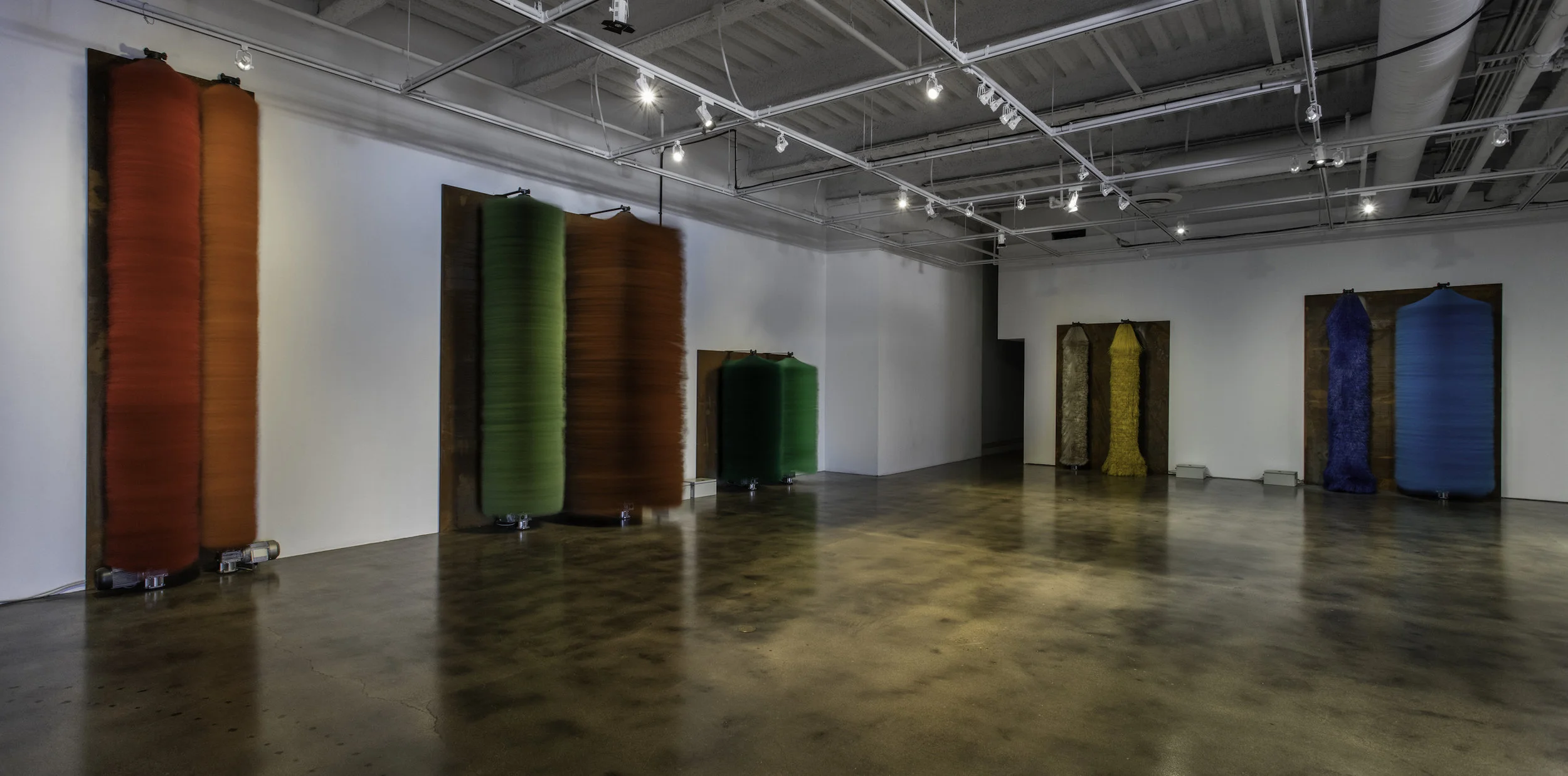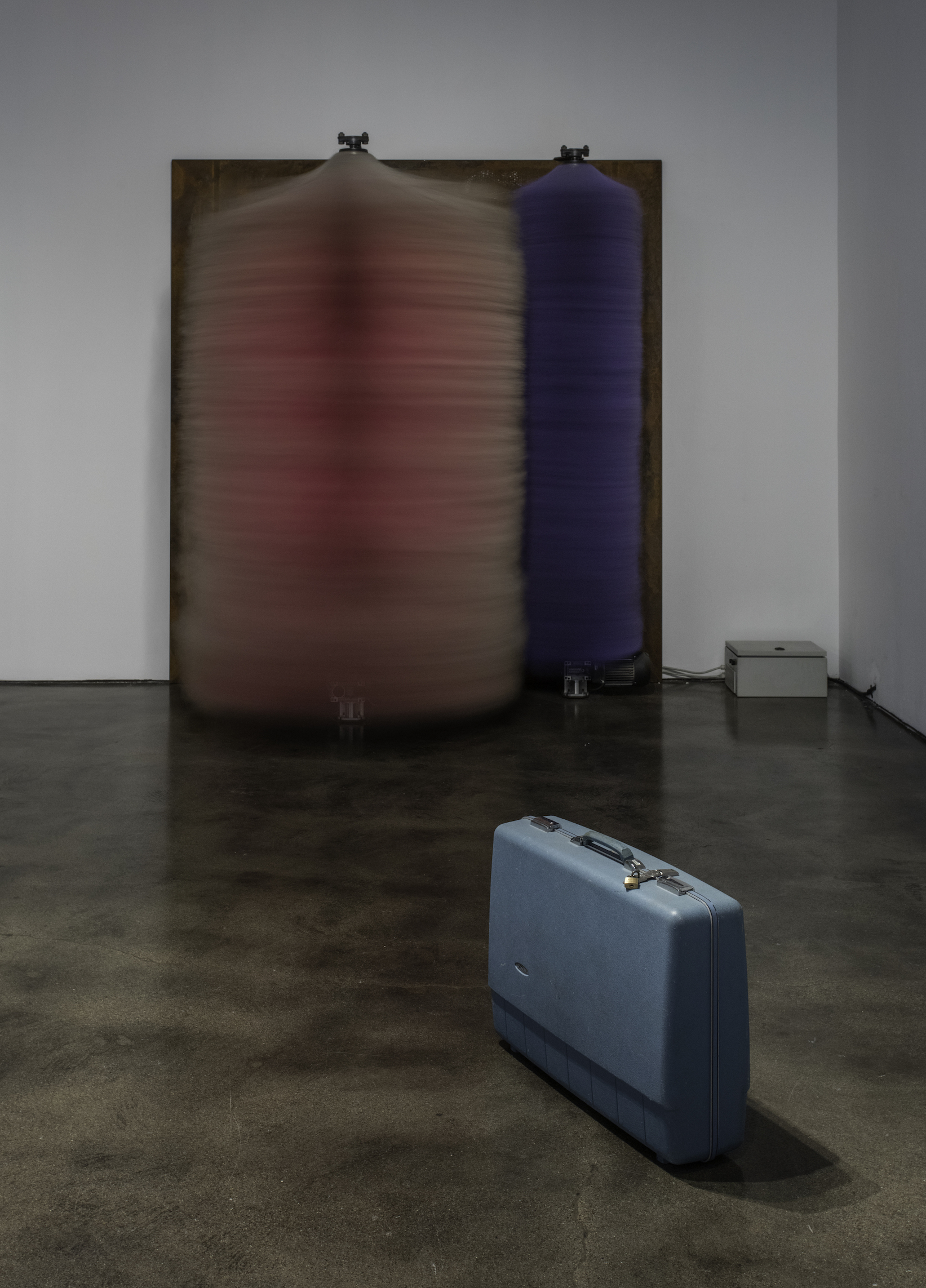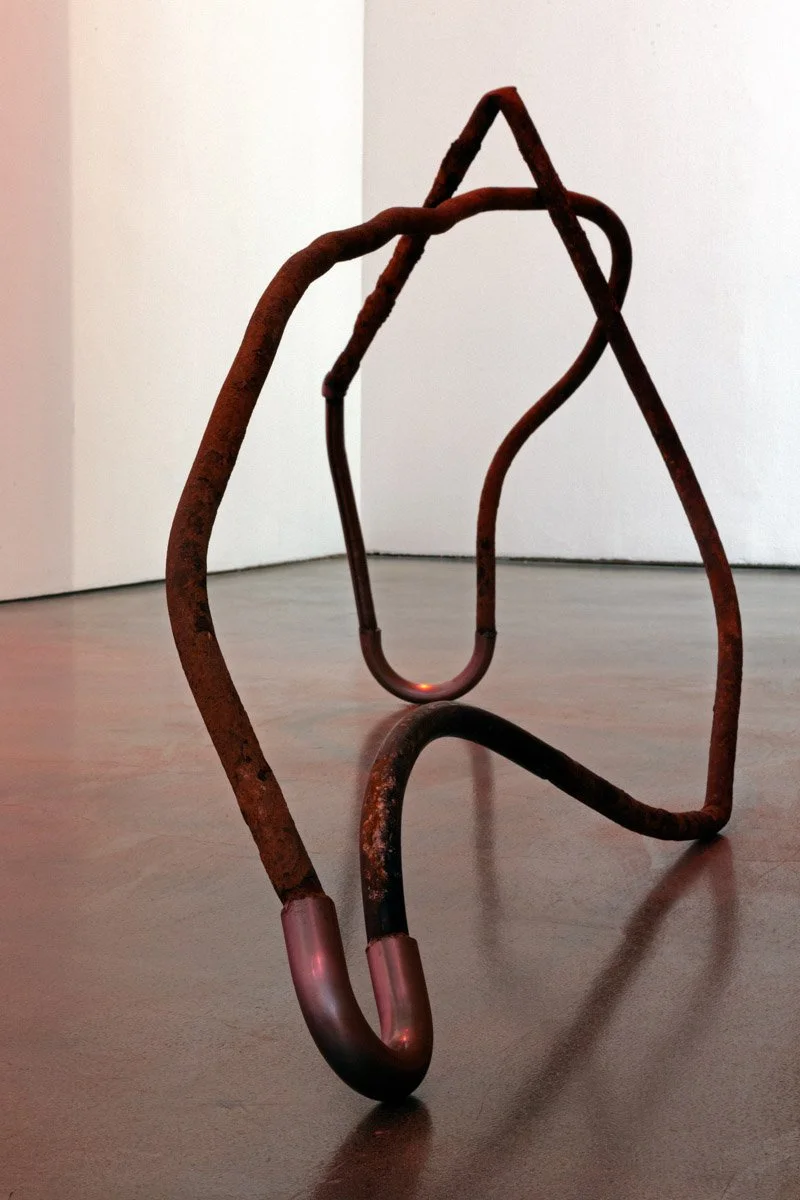In Conversation: Abaseh Mirvali and Wendy Chang on Lara Favaretto
On the occasion of the opening of Museum of Contemporary Art Santa Barbara’s solo exhibition of artist Lara Favaretto, the museum’s executive director, chief curator and CEO, Abaseh Mirvali, spoke with Wendy Chang, director of Rennie Museum and Collection. The conversation has been transcribed and edited for publication in Lum Art Zine.
Lara Favaretto, Coppie Semplici / Simple Couples, 2009, Car wash brushes, iron slabs, motors, electrical boxes, wires, site specific installation, Courtesy Museum of Contemporary Art Santa Barbara. Photo: Brian Forrest
Abaseh Mirvali: I was thinking about what artist I was going to start my tenure with as director and chief curator. I don’t know if many of you know, but I’d been living abroad for the last 17 years. I was surprised that people had such opinions, saying “it has to be an African American artist,” “it has to be a female artist,” “it has to be this kind of artist.” You know, you go with the artists that you think are going to represent the philosophy that you want for this museum (a philosophy based on congruence in life), and the reason that I settled on Lara is that not only did her works make a tremendous impression on me, but I was so moved by her work, particularly the concrete pieces. (These pieces belong to a series that came to life in 2010 and are basically blocks of recently-poured concrete, on which Lara imprints an action with either her body or a construction tool, and thus, starts a dialogue between the material, the gesture imprinted, and the audience’s reaction to what each piece has to say. Examples of these works are “Boring” and “Fisting,” which were up at UCSB and are currently shown at MCASB Main Space).
Lara Favaretto, Fisting and Boring, 2012, Concrete, Courtesy Museum of Contemporary Art Santa Barbara. Photo: Brian Forrest
I think the first time I saw one of the concrete works, I just started crying. I had no idea why I was crying. I felt the movement, what she had done with her body, and how she had impacted and molded that sculptural piece—it had just moved me. So, I very much wanted to start my tenure here at MCASB by sharing an artist that had been capable of moving me so much (but also, an artist whose life philosophy is consistent to her working philosophy). At the same time, we could have a long conversation about minimal art, abstract art, arte povera and all the other kinds of “–isms” and how she beautifully works off of that, but what really mattered to me was her commentary on the human condition and how, as beautiful and as moving as these pieces are, they are also meant to make you think about issues of accumulation and why we need to accumulate so much. What we do; how we determine things being worthy or being important or being precious—assigning a value to them. These are all things that really matter to me.
Wendy Chang: At Rennie Collection, we have about ten works right now and likely we’ll be adding more because we absolutely adore Lara’s work. I think when you first see her art, there is a tendency to really be lost in the joy, the playfulness of it. And that is all there. I think that is actually the brilliance of her work— the layers of it don’t necessarily hit you immediately full force. Because I think that could be very hard to take. She has a generosity to the way she makes her art that envelopes you and welcomes you into her magic, and as you sink into it, as you start to experience it— physically experience it, when you’re standing next to one of the brushes and it’s spinning, you’re hearing sounds, you’re smelling the brushes, you’re feeling the wind. It’s a very physical experience. As it starts to wash over you, you start to contemplate.
For Bob Rennie, this was the second work that he acquired. The first was the confetti room, “Tutti giù terra / We all fall down,” that involved 1 ton of confetti, quite a commitment. The second work he acquired of Lara was a set of seven pairs of these brushes, “Coppie Semplici / Simple Couples.” Now no one that I can think of is buying these thinking, “I’m just going to put them in my family room.” So, it isn’t about the ability to just easily put it on the wall.
When Bob Rennie sees these works, he envisions seven pairs of couples at a dinner party. You start to really read the human nature and the human condition and the personalities of every single brush. As this pink one is spinning madly and taking up volumes of space and her partner is quiet. We’ve all known couples like that, where one dominates and then they take turns. They have their rhythm between them, and they have their rhythm amongst them. And when you start to think of it that way, and you’re in the room, you no longer see something as mundane as car wash brushes, you’re starting to see literal personalities represented. You’re starting to read them as people and their colors symbolize something and the spin means something. You start to try to figure out the relationship. Is this a happy marriage? Are they a married couple? Is this a parent and child? All of a sudden, something as simple as car washes—something that, if you’ve ever taken your car through the wash, you probably never even looked at the brushes, you never even considered them—and yet, all of a sudden, Lara has made you think of them and connect them with your life and your human experience.
Lara Favaretto, Lost & Found, 1998, Suitcase, Courtesy Museum of Contemporary Art Santa Barbara. Photo: Brian Forrest
Abaseh Mirvali: Yes, I think that’s very much it. The appropriation (of used or forgotten objects) is a big part of the work and that’s the whole point of her wanting you to focus on these (disposed or lost) things. You know concrete couldn’t be a (humbler) material to work with, but she gives it this energy. So, from an art historical perspective there’s this piece of concrete, it’s a sculpture, but she gave it energy. She gave it movement by infusing her body, by putting in a gesture. Whether she dug, or she punched them.
For me, another reason I wanted to show Lara’s work, particularly the car wash brushes, is I felt a bit like them. “Coppie Semplici / Simple Couples” is an installation comprised of moving, colorful car wash brushes whose image varies constantly as the speed in which they rotate alternates from high-speed to total stagnation). I was in Italy, I felt comfortable, and I was thinking of this move to the United States. This is a particular time in the country; it doesn’t feel like it felt when I was attending UC Santa Cruz or living and working in Washington, D.C., it feels like a time of turmoil. I felt like these brushes. I remember when I met with Lara, and I told her this is what I wanted to do, and she goes, “Why, why the brushes, why not the new work?” And I said, it’s not that I don’t want to have the new work presented, it’s just simply that this represents a state of mind I’m in. I feel like I’m about to be spun big time, and I have been spun big time—in a good way, but also in a challenging way. I felt like these were beautiful to start with.
The series of suitcase works, “Lost & Found,” are often suitcases Lara bids on at auction. These are suitcases that people lost. Airlines lost them, and then after a certain amount of years they auction them off. Lara Favaretto goes, and she bids on them. And she opens them up, and she will hide something in there. Then, she locks them up and you are not allowed to open them. As a result of this, the works can never be shipped. There could be a grenade—a Kalashnikov—in there. We do not know what is in that suitcase. “Lost & Found” is a piece that resonated with me personally and speaks so beautifully to everything that she is concerned about and that has come up over and over in her work: feelings of people who have been forgotten or want to be forgotten, or have been disappeared involuntarily, or just the concept of loss or being forgotten and what that means.
Lara Favaretto, Coppie Semplici / Simple Couples, 2009, Car wash brushes, iron slabs, motors, electrical boxes, wires, site specific installation, Courtesy Museum of Contemporary Art Santa Barbara. Photo: Brian Forrest
Wendy Chang: The interesting thing about the suitcase is that it was created in 1998. It is a twenty-year-old piece. Artists always want their new work to be seen. That’s understandable. One of the incredible powers of Lara’s work is that it is timeless. You have a suitcase that, the closer you look at it, it’s instantly dated. No one has a suitcase like that anymore. This piece looks so timeless, it’s so nostalgic, it makes you think of grand European trips. It makes you think of these amazing things that can happen when you travel. But when it’s just left on its own, rather forlorn—suddenly, because of our more current history—something that once was just an innocent thing, is so loaded with threat, so invested with fear. Now when Lara created this work, 9-11 hadn’t happened. There wasn’t heightened security like we have these days. You’re never going to find a random suitcase just left somewhere without it being a security emergency.
An artist doesn’t have to be able to see into the future. What an artist has, is the ability to tap into the human experience. The works that were created twenty years ago, before massively historical things happened, those works can still carry on, and carry on with their original loaded meaning, and then carry new meaning.
Lara Favaretto, Tutti giù terra / We All Fall Down, 2004, Confetti and fans, Courtesy Museum of Contemporary Art Santa Barbara. Photo by Carly Otness
Abaseh Mirvali: I think it is important to remember that she is talking about what our place in the world is. For me, as the director of this wonderful institution with this tremendous history, it was important that we start the program talking about collaboration, outside the city and within the city. It was important to support State Street. It was not easy to acquire the storefront for the confetti work, “Tutti giù terra / We All Fall Down.” We wanted to show that if you put culture in the center of people’s lives, it will start conversations.
…
Video of this conversation, created by Alex Blair, can be found here.
“Lara Favaretto” is on view from February 12 to April 28 at Museum of Contemporary Art Santa Barbara, 653 Paseo Nuevo, 907 State Street and 35 Anacapa Street.
•
Want to write for Lum Art Zine? Contact editor@lumartzine.com.
Interested in how you can support Lum Art Zine? We are currently seeking sponsors for Lum Art Zine’s Summer 2020 issue. To get involved or to make a donation, contact editor@lumartzine.com.









